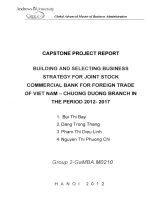Determination of temperature gradient and spectrum in the mold’s core and wall by solving the differential equations using Wolfram Mathematica software
Bạn đang xem bản rút gọn của tài liệu. Xem và tải ngay bản đầy đủ của tài liệu tại đây (396.19 KB, 5 trang )
Journal of Science & Technology 135 (2019) 018-022
Determination of Temperature Gradient and Spectrum in the Mold’s Core
and Wall by Solving the Differential Equations using Wolfram
Mathematica Software
Luu Thuy Chung1,2*, Dinh Thanh Binh1,3, Nguyen Thi Phuong Mai1, Pham Hong Tuan4
1
Hanoi University of Science and Technology - No. 1, Dai Co Viet Str., Hai Ba Trung, Ha Noi, Viet Nam
2
Vinh University of Technology Education, Nguyen Viet Xuan Str., Vinh, Nghe An, Viet Nam
3
Defense industrial college, Thanh Vinh, Phu Tho, Phu Tho, Viet Nam
4
National Center for Technological Progress, C6-Thanh Xuan Bac, Thanh Xuan, Ha Noi, Viet Nam
Received: December 08, 2017; Accepted: June 24, 2019
Abstract
Using of mathematical tools to calculate, simulate the technical problems was widely being used by many
researchers. This study was developed based on the Wolfram Mathematica software to determine the
temperature spectral and temperature gradient transmittance in the mold’s wall and core, in order to
determine the influence of the material thermal conductivity to the mold temperature gradient, as well as
evaluating the effect of changing the position of the mold surface to the thermal gradient in the mold. The
calculations demonstrated that the increasing of the coefficient of thermal conductivity of the mold material
would reduce the temperature gradient of the mold, and the mold walls were identified to have higher
thermal gradient than in the mold’s core that were in similar working conditions. The experiments had also
shown that TiN and CrN had the same temperature and temperature gradient spectrums as the SKD61, but
the gradient values on their surfaces were higher than those of SKD61 and the slopes were higher, too.
Keywords: Thermal differential equation, temperature spectrum, thermal gradient spectrum
1. Introduction1
casting mold and on the mold surface characteristics
in the mold to the thermal gradient.
Using mathematical tools to solve the heat
transfer problem was investigated in the field of
mathematics while physics or informatics studies the
ability of software to solve the problem of heat
transfer by software [1]. In the field of foundry
research, the author [2] has given the mathematical
solution to the problem of heat transfer in the mold in
a static state by using error function. Some other
researchers used simulation softwares to simulate the
thermal processes in the mold [3, 4].
In temperature field of the mold, due to the
difference in temperature between the locations in the
wall, according to the laws of thermal expansion of
the material, the mold material expanded unevenly
between the positions, which caused stress in the
mold. The stress produced in a tiny part of mold was
proportional to the difference in elongation of the
edges following a x direction, thus the thermal
gradient stress is:
Thermal fatigue was one of the major failures of
in high pressure die casting (HPDC) mold, which was
a widespread and unavoidable phenomenon [5-9].
Numerous researches had shown that the thermal
stresses occur in the HPDC mold due to heat
gradients and temperature raise in the mold. The
temperature of mold was always increased due to the
contact of the mold surface and the molten metal, so
the stress component due to the temperature rising
was an inevitable factor component. This study
focuses on the influence of the physical properties of
the material on the thermal gradients of the die
E. E.
.grad x u.dx
dx
E. .grad x u
(1)
The equation (1) shows that the temperature and
gradient of mold greatly affect to the stresses at
different positions of the mold during processing.
Further studies determined the thermal together with
gradient spectrums of the mold that occur to further
clarify the thermal stresses of the mold. Considering
two models of heat transfer: through flat wall
(equivalent to heat transfer through mold walls) and
into square root (equivalent to thermal transfer of
core).
Thermal equation for heat transfer (Fourier
equations) [10]:
1
Corresponding author: Tel.: (+84) 98.234.1350
Email:
18
Journal of Science & Technology 135 (2019) 018-022
2u 2u 2u
u
a 2 2 2
t
y
z
x
In the first case, in order to simply the problem,
considering the remaining 2 other directions of the
wall are large enough, the problem can be seen as one
direction heat transfer. In this case, there is no y and z
components in differential equation, so equation (3) is
the form of equation (2) in this case. The equation
can be shown as equation (4) in the software.
u
2u
a 2
(3)
t
x
(2)
Here, u is the temperature; t is time and x, y, z
are coordinates with a
determinate by λ - The
cP .
specific heat of the material, ρ - Specific mass of the
material. The values λ, cP, ρ for some materials [11]
related with this study were shown in Table 1.
D[u[x,t],t]==a*D[u[x,t],x,x]
Table 1. Specific heat (C), density (ρ), heat transfer
coefficient (λ) and thermal conductivity (a)
Material Specific Density, Heat
heat, C ρ
transfer
(kJ/kg.K) (g/cm3) coefficient,
λ(W/m.K)
Steel 0.45-0.50 7.8
50
SKD61 0.46-0.59 7.6-7.8 24.3-27.5
TiN
CrN
W
0.78
0.73
0.14
5.22
6.14
19.3
19
12
173
For the second case of heat transfer in the mold:
When heat is transferred to the square core, the z
component is not involved in the differential
equation, in this case the equation (2) is expressed as
equation (5) and (6).
2u 2u
u
(5)
a 2 2
t
y
x
Thermal
conductivity,
a (mm2/s)
14.24-12.82
≈6.78
(100-300 °C)
4.67
2.68
64.03
D[uu[x,y,t],t] == a*(D[uu[x,y,t],x,x] +
D[uu[x,y,t],y,y])
The boundary conditions of the differential
equation were the surface temperature of the mold. In
the case of wall part, the surface of the mold is the
surface of the molten liquid contact, with a thermal
cycle described as curve 1 (Fig. 1a), the outer surface
is a cyclic air contact surface as shown by curve 2
(Fig. 1a), in the case of the core of the mold, all the
faces of the mold part are cast metal contact surfaces,
and all of them use the spectral 1 in Fig. 1a. In this
case, Fig. 1a is a graph of mold temperature from the
document of casting machines (company Z117 Ministry of Defense). These curves took similar
forms to the results of other researches in [3, 12, 13].
As indicating, the initial condition of the
problem is that the mold temperature at the starting
time of the process is the ambient temperature. This
initial condition is described as follows:
Temperatur
2
a
u[x,0] == 22
(7)
uu[x,y,0] == 22
(8)
In these cases, we use Dirichlet Boundary
Condition by describing the mold surfaces’
temperatures. To simply describe the thermal of mold
surface in the differential equation, the charts (shown
in Fig. 1a) is rescaled, divided into sort parts,
linearized and define by the form of function as Eq.9.
points in the mold
Inner surface
1
(6)
The value of thermal conductivity (a) in the
functions (3, 4, 5, 6) depends on specifically material
as shown in Table 1, in these experiments, we use 4
“a” values of mold material SKD61, hard coating
material TiN, CrN and W.
2.2. Initial conditions and boundary conditions
Initial condition of the differential equation is
the mold temperature at the start state, choosing
ambient temperature. In this case the ambient
temperature is 22 °C.
Outer surface
(4)
0 t t01
u01 u '01 t
u u ' t t t t
02
01
02
u0 02
...
...
u0 n u '0 n t t0 n 1 t t0 n
b
Time (minute)
Fig. 1 Temperature variation at points in the mold
over time: (a) real charts and (b) simulation chart
(9)
Two functions that defined by the Mathematica
software’s Function Piecewise ndbmkhuon[t] and
ndmnkhuon[t] have been created. Fig. 1b shows the
charts of the functions ndbmkhuon[t] and
ndmnkhuon[t] in the software. Comparison of Fig.1a
and Fig.1b shows that the charts of the functions are
similar to the origin chart, so we can use these
functions in models.
2. Numerical Modeling
2.1. Setup the differential functions
There are 2 main cases of heat transfer on the
mold. Heat transfer through the wall and heat transfer
into the core.
19
Journal of Science & Technology 135 (2019) 018-022
achieved at 275.7s (or 5.7s of the cycle). Fig. 5 shows
the thermal gradient spectrum of the mold in a section
along the thermal transmission direction also
recognizes the highest gradient values on the mold
surface. These maximums depended on the thermal
conductivity of the material. The lower thermal
conductivity of material is (CrN, a = 2.68; TiN, a =
4.67), the higher gradient value had achieved on the
surface (about 29 °C/mm and 22°C/mm). On the
contrary, the better heat conducting material (W, a =
64.03) had the lower gradient value on the mold
surface (about 7.5°C/mm).
2.3. Solving the models
To solve the differential equations (4), (6) with
the initial conditions (7), (8) and the boundary
conditions as ndbmkhuon[t] and ndmnkhuon[t]
functions, we use the NDSolve function. The full
setup functions are shown as equation (10) and (11).
nhiet=NDSolve[{D[u[x,t],t]==a*D[u[x,t],x,x],
u[x,0]==22,u[0,t]==ndbmkhuon[t],
u[50,t]==
ndmnkhuon[t]},u,{x,0,50},{t,0,300}]
(10)
nhiet2=NDSolve[{D[uu[x,y,t],t]==
a*(D[uu[x,y,t],x,x]+D[uu[x,y,t],y,y]),uu[x,y,0]==22,
uu[0,y,t]==ndbmkhuon[t],uu[50,y,t]==ndbmkhuon[t],
uu[x,0,t]==ndbmkhuon[t],uu[x,50,t]==ndbmkhuon[t]
},uu,{x,0,50},{y,0,50},{t,0,300}]
(11)
The thermal gradients dropped drastically near
to the surface and then slowed down further when
deeper. The thermal gradients on the surfaces of the
less heat conduction materials (CrN, TiN) decreased
faster (slope of CrN is 6.6°C/mm2 at the surface,
2.4°C/mm2 at 5mm depth, the slope of TiN decreased
from 3.75°C/mm2 on the surface to 1.9°C/mm2 at
5mm depth) than the better thermal conductivity
material’s (W has 0.28°C/mm2 on the surface and
0.24°C/mm2 at a depth of 5mm) as shown in Fig. 5.
The equation (10) is used to solve the
temperature function u[x,t] in the case of 1D thermal
transfer. The equation (11) is used to solve the
temperature function uu[x,y,t] in the case of 2D
thermal transfer.
The thermal gradient in the material is
illustrated by taking the derivative of the temperature
function u[x,t] or uu[x,y,t] along the x-axis with the
function D[u[x,t],x] or D[uu[x,y,t],x].
Figures 4c and 5c presented that SKD61 had a
gradient value up to 18,383 °C/mm on the surface at
275.7s.
3. Discussions
The thermal conductivities of the two coating
materials in these simulations were lower than those
of SKD61 and close to the coefficient of thermal
conductivity of SKD61. The charts of these two
materials are similar to those of SKD61 but the
maximum value (on the surface) of the highest
thermal gradient and the slope of the charts is higher
than the charts of SKD61 (2.54°C/mm2 on the surface
and 1.54°C/mm2 at the depth of 5mm) as shown in
Fig. 5.
Usage of the Plot and Plot3D function for
representing the interpolation values of the heat
transfer functions in the 2 and 3-dimensional charts to
fully observe the temperature fields and the
temperature gradient distribution field in various
materials or shapes.
3.1. Effect of thermal conductivity to thermal
gradient
The equation (10) has been solved with different
values of “a” to evaluate the effect of the thermal
conductivity “a” on the thermal spectrum and thermal
gradient spectrum. In Fig. 2, 3, 4, the temperature and
thermal gradient changed for cases a = 2.68, a = 4.67
(low enough “a” values), a = 6.78 (coefficient of
thermal conductivity of the SKD61 mold), and a =
64.03 (high enough “a” value).
As the thermal conductivity increases from 2.68
to 4.67, 6.78 and 64.03, the faster the material
reached the stable state (from the 10th cycle to the 7th
cycle) as shown in Fig. 2. Figures 2 and 3 also
showed that, as the thermal conductivity increased,
the influence of thermal oscillations was deeper (from
less than 10 mm to greater than 40 mm). Temperature
variations at points in the mold wall are consistent
with the results in the previous study [3]. Fig. 4
illustrates that the thermal gradients reached the
highest value on the mold surface, which was
a
b
c
d
Fig. 2 Temperature spectrums in first 10 cycles by
materials: (a) CrN (a =2.68); (b) TiN (a = 4.67);
(c) SKD61 (a =6.78) and (d) W (a = 64.03)
20
Journal of Science & Technology 135 (2019) 018-022
a
a
b
c
d
b
c
Fig. 3 Temperature spectrums in the 10th cycle by
materials: (a) CrN; (b) TiN; (c) SKD61 and (d) W
d
e
b
a
c
Fig. 6 Thermal spectrums in the (square) SKD61
core: (a) temperature spectrum in the first 10 cycles;
(b) temperature spectrum in the 10th cycle; (c) thermal
gradient spectrum in the 10th cycle; (d) temperature in
a cross section at 275.74s; (e) thermal gradient
spectrum along the section at 275.74s
d
3.2. Effect of position in the mold to the temperature
field
Fig. 6 is the results of the thermal process
simulation taking place in the SKD61 core by solving
the differential equation (5) with the boundary
conditions ndbmkhuon as the equation (11). Fig. 6d
shows that the longitudinal section at the center of the
core resulted in the highest thermal gradient. The
maximum value of the thermal gradient appeared at
275.74s on the mold surface (Fig. 6c). In comparison
with the wall case (Fig. 2c), Fig. 6a shows that in the
case of a mold core, thermal processes were rapidly
gaining stability (from the eighth cycle). In contrast
to wall case (Figures 2c and 3c), Fig. 6a and 6b
showed that the heat in the core affects to the entire
cross section of the core.
th
Fig. 4 Thermal gradient spectrums in the 10 cycle
by materials: (a) CrN; (b) TiN; (c) SKD61 and (d) W
a
c
b
d
Figures 6c and 6e showed that the thermal
gradient reached the maximum value on the mold
surface at 16°C/mm. Fig. 6e also showed that the
slope of the heat gradient graph in the case of the core
was also smaller than that of the wall at the near
surface (2.8°C/mm2 on the surface and 1.5°C/mm2 at
5mm depth).
Fig. 5 Thermal gradient spectrums in a section along
the thermal transmission at the time of 275,7s by
materials: (a) CrN; (b) TiN; (c) SKD61 and (d) W
4. Conclusion
The thermal conductivity factor had influence
on the spectral shape and the maximum gradient
value on the surface. Thermal conductivity of CrN as
2.68, which was the lowest value of these simulations
21
Journal of Science & Technology 135 (2019) 018-022
process for copper pipes, International Journal of
Heat and Mass Transfer 115 (2017) 294–306.
in our researched materials. Simulation illustrated
that the gradient of CrN was the highest value (about
29°C/mm) by contrast to W (a = 64.03) with the
gradient value of 7.5°C/mm.
The thermal conductivity of the cores quickly
attained stability (at the eighth cycle toward) over the
walls (at the tenth cycle toward). After achieving
stability, each cycle time ~5.7s would be the time
when the mold surface temperature and the thermal
gradient on the mold surface was highest. In general,
the thermal gradient of the mold core (16°C/mm) was
smaller than that of the wall profile (18,383 °C/mm).
Gradients dropped very fast (6.6°C/mm2 – CrN,
3.75°C/mm2 – TiN, 2.55°C/mm2 – SKD61) on the
surface, then changed slowly in deep points
(2.4°C/mm2 – CrN, 1.9°C/mm2 – TiN, 1.75°C/mm2 –
SKD61 at 5mm) of the mold.
The thermal stresses of coating materials were
higher than that value of SKD61, the coating layer
had great thermal gradient, so the mold substrate
lifetime was extended as shown in [2].
The
results
of temperature
evolution
calculations are consistent with previous study [3].
Huỳnh Thị Thuý Phượng - Ứng dụng phần mềm
Mathematica cho lời giải bài toán truyền nhiệt – luận
văn thạc sỹ khoa học, ĐH Đà Nẵng, 2012.
[2]
Nguyễn Hữu Dũng – Các phương pháp đúc đặc biệt –
NXB Khoa học kỹ thuật, 2006.
[3]
A. Srivastava, V. Joshi, R. Shivpuri - Computer
modeling and prediction of thermal fatigue cracking
in die-casting tooling - Wear 256 (2004) 38–43.
[4]
Yi Han, Xiao-Bo Zhang, Enlin Yu, Lei Sun, Ying
Gao, Numerical analysis of temperature field and
structure field in horizontal continuous casting
Amit Srivastava, Vivek Joshi, Rajiv Shivpuri, Rabi
Bhattacharya, Satish Dixit - A multilayer coating
architecture to reduce heat checking of die surfaces Surface and Coatings Technology 163 –164 (2003)
631–636.
[6]
Changrong Chen, Yan Wang, Hengan Ou, Yueh-Jaw
Lin - Energy-based approach to thermal fatigue life of
tool steels for die casting dies - International Journal
of Fatigue 92 (2016) 166–178.
[7]
S. Jhavar, C.P. Paul, N.K. Jain - Causes of failure and
repairing options for dies and molds: A review Engineering Failure Analysis 34 (2013) 519–535
[8]
V. Nunes, F.J.G. Silva, M.F. Andrade, R. Alexandre,
A.P.M. Baptista - Increasing the lifespan of highpressure die cast molds subjected to severe wear Surface & Coatings Technology 332 (2017) 319–331
[9]
R. Shivpuri, Y.-L. Chu, K. Venkatesan, J.R. Conrad,
K. Sridharan, M. Shamim, R.P. Fetherston – An
evaluation of metallic coating for erosive wear
resistance in die casting applications – Wear 192
(1996)
[10] Phạm Lê Dần, Đặng Quốc Phú – Cơ sở kỹ thuật nhiệt
– NXB Giáo dục Việt Nam, 2010
References
[1]
[5]
[11]
[12] Alastair Long, David Thornhill, Cecil Armstrong,
David Watson - Predicting die life from die
temperature for high pressure dies casting aluminium
alloy - Applied Thermal Engineering 44 (2012), 100107
[13] Matevž Fazarinc, Tadej Muhič, Goran Kugler, Milan
Terčelj - Thermal fatigue properties of differently
constructed functionally graded materials aimed for
refurbishing
of pressure-die-casting
dies
Engineering Failure Analysis 25 (2012) 238–249
22









